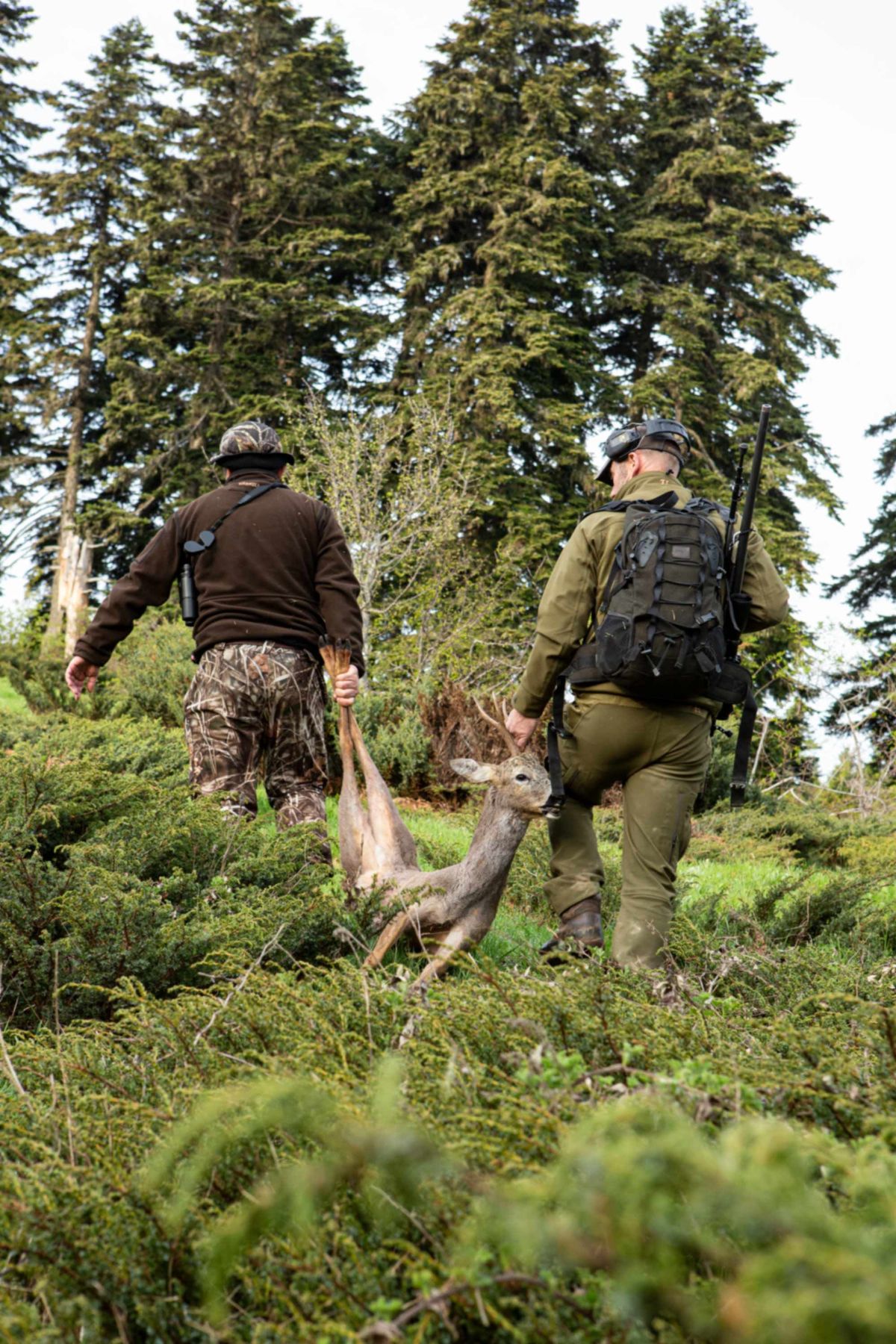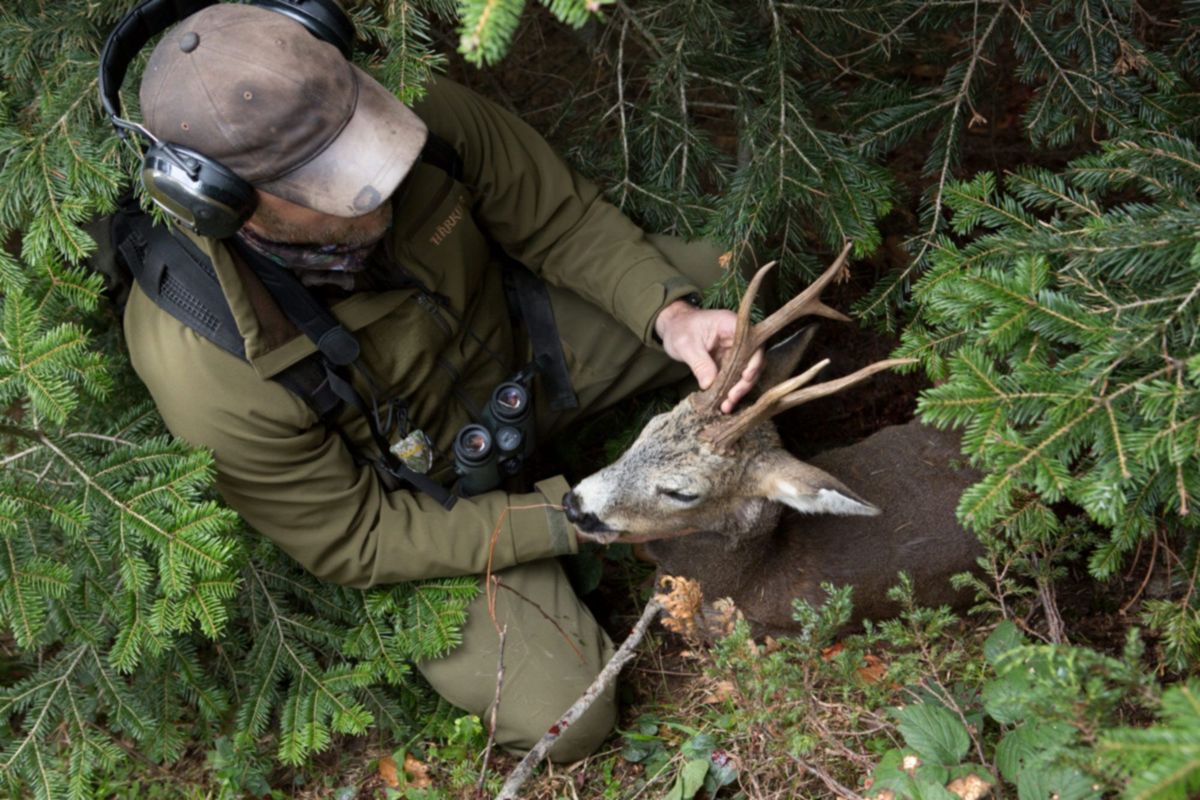Stalking
Summer Hunt for Anatolian Roebuck
The antlers on the roebuck below us are not impressive. The two tips between the ears on the animal represent far from the mature capital buck, Jens Kjaer Knudsen has travelled to Turkey to hunt.
It is his first encounter with this Asian "subspecies" of roe deer, but already we now discovered that the animals here are very attentive. This young animal discovered us hundreds of meters away and constantly barked during the escape - the hunt in this valley was over for the morning.

Anatolian high seat
It's late afternoon. We drive through forest roads, through one mud hole after another. Kilometre by kilometre, we have been shaken around in the vehicle. Then our guide, Erol Ak, suddenly stops the car in the middle of the forest. A little further, the forest seems brighter than here under the green beech crowns. That lightning of open meadows is the target of the long drive. This is where Erol earlier has seen an old buck several times.
Typical for hunting in stranger countries, nothing is as one expects. The “high seat” we are going to sit in turns out to be an old cabin. In the summer, shepherds use the cottage. They live here in the mountains with their livestock, but on this spring day, the house will work as a high seat. All around the cottage are grazing landscapes with succulent grass, various herbs and a million yellow flowers. The whole glory is surrounded by forest as far as the eye reaches.
We divide ourselves into the rooms so Erol covers the east side. The hunting officer from authorities, who has to be present during all hunts, covers the south side. Jens and I share the last two corners of the world between us. Shortly before sunset, a doe slides over the open area. She seems nervous and disappears quickly into the woods again.
An equally nervous buck goes into the ground just before the sun disappears. It passes the "high seat" in less than 100 meters distance, but it is not old enough even though it's a nice six-pointer. The animal's behaviour might also indicate that there are more bucks around this optimal biotope, some of them probably of considerable age.
Echo from the minaret
The hunt takes place in Turkey, at an altitude of 1.300 meters, in the mountainous areas of the Black Sea region. Everywhere in the mountains, small villages are placed, and each village has its own mosque. From these, several times a day are called for prayer. The verses can be heard everywhere in Cangal – our 29.000 hectares of hunting ground.
It has become so dark that even bright optics can no longer work when they call for evening prayer. The buck in the dark does not respond to the echo that strikes between the hills. He has heard the prayer several times a day throughout his life. He continues to eat. If prayer helped us, it would be nice, as it seems like we need some luck.
Erol now takes a thermal optic in use. During the next hour, we see, among other things, a female bear with two cubs only 300 meters from the cabin. Funny enough, the deer is still undisturbed, even though it's just 200 meters from the huge carnivores. The deer's movements can be seen as a white drawing on display, indicating that it is an older animal. Anyway, it's too dark, and we will never get a chance to shoot. We have to make the long drive back to the hotel and get four hours of sleep before we have to hunt again.
Buck after buck
One evening we sit on the ground between the rocks over a small lake. We have been driving for about 50 minutes on gravel and dirt roads in a 4x4 to reach this magnificent place. It has been a worthwhile trip; the place is a little paradise in the middle of the forest. It will not be long before a young six-pointer buck shows up 100 meters below us. The animal quickly passes the open area but offers a perfect shot multiple times. Nevertheless, it is too young; at least one older buck must be in here – we will wait for that.
Suddenly a four-pointer slides down the forest edge on the opposite side of the open area. It disappears in a thicket a few hundred meters to the left. Shortly afterwards, a tall six-pointer with long spikes follows. It is exactly a buck like that we are after. The pattern of movement, the thick neck and the big body tell us that there is no doubt an older buck. He brings the snout into the ground, in the track of the youngster.
The old buck disappears in the same thickness as the young. Seconds after, he passes under us. He is at full speed over the open area. He is only 80 meters away but does not offer a chance for Jens. The old buck comes closer tailing the young buck just beneath us. Ten seconds later, both bucks are absorbed by the forest. We will not see them again – a plan for next morning's hunt has to be made.

Bear tracks in the grass
We have just been sitting for half an hour, as Erol wants us to go stalking. A bad idea, it seems to Jens. Partly it is very loud when we move around and there are few open spots in the woods around the slope. After another half hour, Erol insists, and Jens has to give in. Without a sound, we climb down the rocks and cross the short grass towards the forest corner where the buck came from last night. Along the way, we pass fresh bear tracks in the grass, but there is no time to think of the bear – it's all about the buck.
Erol stiffens in the middle of a movement, pointing downwards and mimics to Jens that shooting is now. Jens takes a step forward. I see him sit down, shoulder the rifle and put the cheek onto the stock. I cannot see anything, but it seems he will take the shot. I take the chance to move half a meter forward so I'm just behind Jens. From there, I see the buck. He knows something is wrong but is not sure if there are dangers or if it is a young buck that needs to be put in place.
The antlers are partly out of sight behind a branch, but the whole body is free. From the body size, the skin colour, the animal's pose and the part of antlers seen just under the branch, Jens considers if it's an elderly buck.
The right buck?
Jens is not entirely sure that it's the old buck from yesterday that he has shot. He just know that it's an old buck. The photo cannot illuminate the doubt, so it's with extra excitement he and Erol follow the blood trail. Jens lifts a branch where it ran in the woods and breaks out in jubilation. It's the buck from yesterday, the one we went for.

It's a stroke of great luck but not luck in itself. The more you prepare, the more you train, and the more experienced you are, the luckier you are. So anyway, perhaps one of the many prayers from the minarets in the mountains helped Jens and me. We do not know - but with the result considered, it is definitely an option. Masha Allah!

Subspecies of roe deer:
Several subspecies of roe deer are found in Europe and Asia. These are according to CIC and SCI:
- Siberian roe deer (found in large parts of Asia and some parts of Europe).
- Chinese roe deer (found in China and some neighbouring countries).
- Black roe deer (primarily known from Germany).
- Italian roe deer (found in Italy).
- Andalusian roe deer (found in Spain).
- European common roe deer (most of Europe and parts of Asia).
Roe deer can be found in a variety of subspecies throughout Europe, Asia and a few other places. The "subspecies" we are hunting on this trip are popularly referred to as Anatolian roe deer. Anatolian roe deer is almost the same as the common European roe deer, but with a higher body weight. Older bucks in Turkey will generally weigh from 30 up to 37 kilos live weight.

Over the past few days, we have seen a few roebucks. They have been in almost constant motion, and rarely have we seen them eat. In spite of the low hunting pressure, Turkish roe deer are very cautious compared to what they are on most European hunting grounds, moreover, with good reason. Roe deer is last in the food chain. Both wolf, lynx, fox and bear, not to mention the enormous wild boar, like the “tender” beef of roe deer. The wild boars in Turkey can achieve enormous dimensions. It is not uncommon for keilers to weigh more than 300 kilograms.
Roebuck licenses issued in Turkey:
They had hunted roebuck on the 29.000 hectares we have been hunting since 2013. Only three roebucks were shot over these years. Roebuck hunting is not particularly popular in Turkey, and very few animals are taken annually. Our guide, one of the most experienced hunters in Turkey, estimated that only 100 animals had been shot in recent years. The roe deer is managed through a licensing system, but in principle, outfitters will get the licenses needed for current customers.
Games species to combine with roebuck hunting:
Turkey has lots of wild boar. Hunting for Anatolian roebuck, therefore, can easily be combined with hunting for wild boar. Often hunters will encounter wild boar during the stalk for roebuck, but primarily the wild boar hunt is done as night stalking along forest tracks on which the guide in several areas has spread corn. The boars are active from sunset and some hours ahead. You almost do not believe your own eyes because, in nearly every place with corn, you will find a strong keiler. He keeps the sow and youngsters away from good feeding places. On this trip, we took two boars with teeth beside the roebuck at approx. 20 cm and 24 cm.
The wild boar is a big nuisance for the poor mountain farmers, as they are not hunted quite hard. Turkish hunters are generally meat hunters, and since the majority of Turks are Muslims, it makes no sense for them to chase the pigs. Where the meat from roe deer is regarded as a delicacy, wild boar meat is not used. However, they do not waste because the many carnivores in the mountains enjoy the meat. Anyway, our guide Erol Ak worked on plans for processing the meat. Not for the kitchens to understand, but processing for dog and cat food.
Hunting season and best time:
The best time for chasing roebuck in Turkey is between 15 April and 15 May. The hunting season may vary from year to year, but usually, the hunting season starts on 1 April and runs until 31 October. For ethical as well as religious reasons, there is only hunting time for females. Thus, the management stays in contrast to common Western European management, where we take care of the total number of animals. In the Black Sea region, the hard winter with up to two meters of snow and the many carnivores are so hard on the animals that only the strongest can survive.